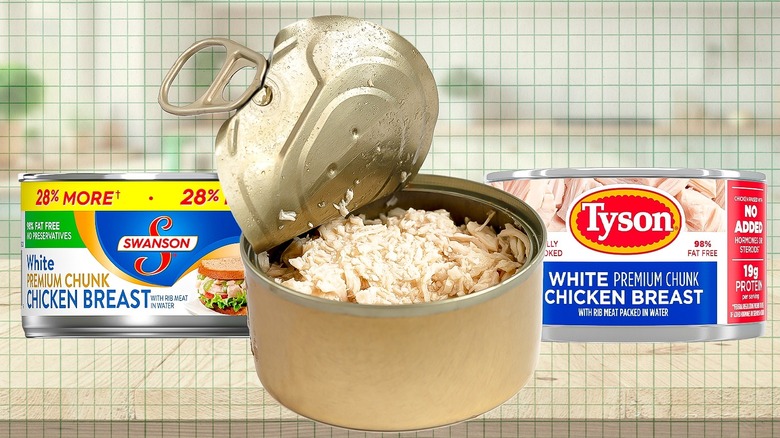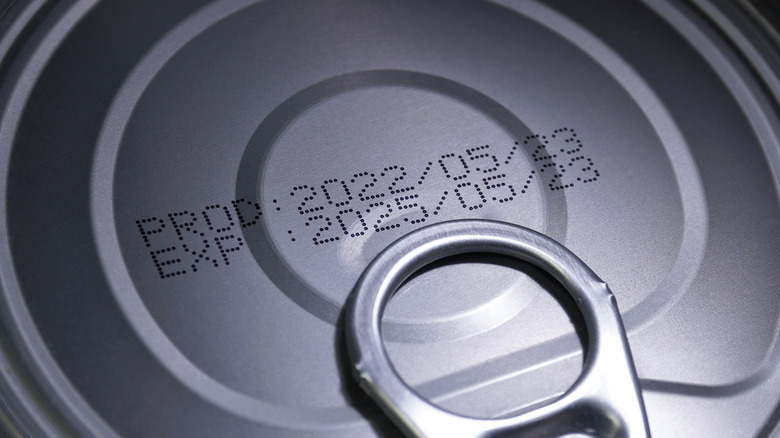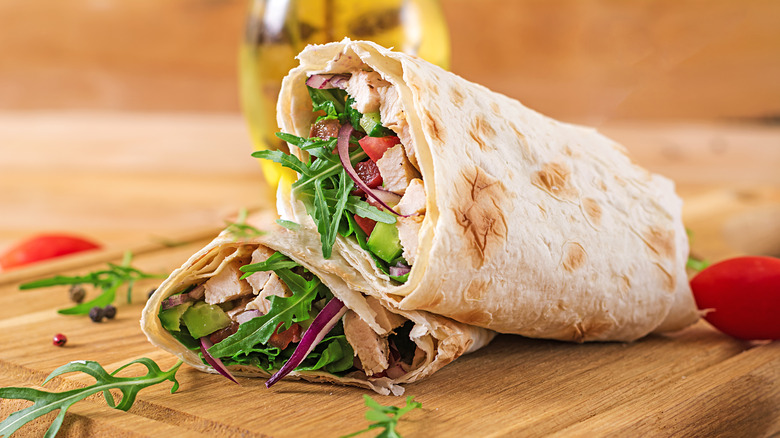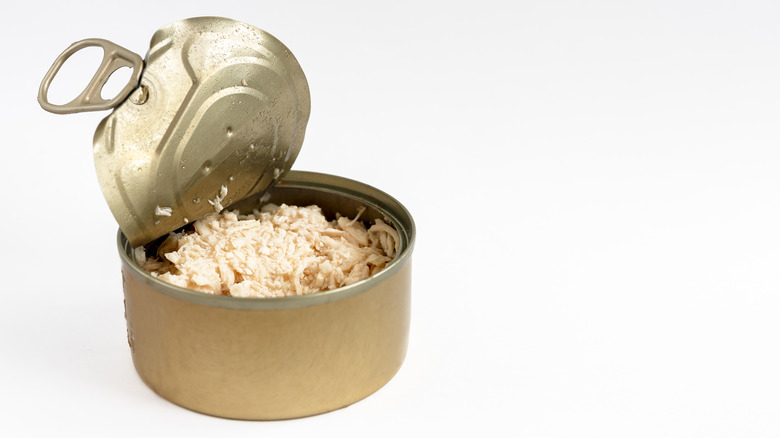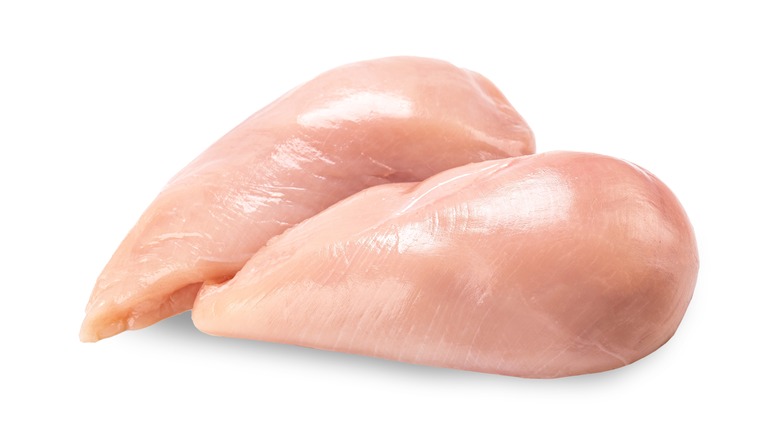8 Canned Chicken Myths You Need To Stop Believing
Canned foods can sometimes catch a bad rep. "Gourmet" isn't usually the word that comes to mind when you think of them. From beans and pickled ingredients to meats, there are many underrated canned goods. They not only elevate everyday eats but also save you money and time in the kitchen. Chicken is one of the most versatile canned meats around. Beyond a tuna substitute, it's a crave-worthy addition to salads, casseroles, chicken noodle soup, stir-fries, and more.
The missing ingredient to make pot pie dinner easier is canned chicken. The beef-free burger substitute you've been craving? Yup, you guessed it — canned chicken. Admittedly, the idea of eating chicken from a can sounds weird, and there are still myths about it that don't exactly whet the appetite. You may have heard tales of dangerous sodium levels or of it being a less healthy alternative, but we're here to dispel those. Canned chicken is a pantry must-have and these are myths you need to stop believing.
A pinkish hue is a sign of undercooked chicken
Studies have proven that how food looks plays a big part in how much we enjoy it. It can also, obviously, save us from stomach ache-inducing expired foods. That said, sometimes what looks like old food is not old at all. One myth about canned chicken is that pinkish flesh is a sign of it being undercooked. Pausing at the sight of pink chicken is understandable; it's a notorious carrier of salmonella bacteria. But surprisingly, according to the USDA, canned chicken with pink flesh is natural.
It's caused by chemical changes. When cooking chicken, the meat's hemoglobin reacts to gasses that emit from the oven, which turns the flesh pink. Younger birds tend to display the richest pink color because they have less body fat. Another possible cause is nitrates or nitrites, which are naturally occurring compounds frequently added to canned foods as a preservative. Simply put, you don't have to throw this chicken back into the sea just because it's pink. The expiration and "Use-By" dates are better, if imperfect, indicators of freshness — but more on that later.
An expiration date is a red flag
The expiration date on food products has been a major cause of food waste for years. Many of us wrongly believe that "Sell-By," "Use-By," and "Best if Used By/Before" all mean the same thing. And Congress only recently introduced a bill to approve the accuracy of expiration dates. It's especially confusing when trying to determine whether canned chicken is safe to consume. The long shelf life it has is both impressive and concerning. Regardless of what the date says, canned food that's been stored for a long time always begs the question, "Is it still safe to eat?"
Shelf life is one upside to using canned chicken over fresh. It retains a quality taste and texture for a year at least but can last for up to 3 years when properly stored in a cool, dry space away from direct light. If your cans are dent and rust-free without signs of structural damage, they're built to survive the zombie apocalypse. When they are printed with "Best if Used By/Before," it typically refers to the manufacturer's estimates of how long they will retain optimal quality. If the can is labeled with "Use-By," it refers to the last recommended date to consume the product at its peak quality. Neither date confirms whether or not canned chicken has expired.
All canned chicken is high in sodium
Canned chicken is known for being loaded with sodium, and while that is true, it varies considerably from brand to type. There are "low-sodium" and "no salt added" options, but those aren't always the healthiest choices. Sodium phosphate is one of the primary ingredients used by canned chicken brands. Along with preserving deliciousness, it can further enhance flavor. The problem is that consuming too much can pose a health risk.
That's why checking the ingredients in your canned chicken is important. A cheaper brand like Swanson, which offers a "35% less sodium" option, also includes additives. For every 85-gram serving of its 12.5-ounce can, there are 250 milligrams of sodium. If you're hoping to reduce your salt intake without taking on unwanted additives, Keystone is a brand that makes quality low-sodium canned chicken. At only 100 milligrams per 56-gram serving, it's one of the lowest sodium options around. The ingredients list only includes two items as well: chicken and sea salt. Keystone and similarly low-sodium additive-free brands are the healthiest way to go.
It isn't a good substitute for fresh chicken
Contrary to popular belief, there are endless ways to use canned chicken. Not that there aren't limitations, just that you'll be scarfing down too many delicious recipes to notice them. Deciding when to substitute fresh chicken for canned boils down to consistency. When canned, chicken loses much of its taste and becomes super tender. It develops a shredded consistency that can be flavored however you like. That makes it perfect for a wide range of dishes like chicken salad, quesadillas, wraps, chicken noodle soup, and more. You can even enjoy it straight from the can.
That said, it's also known to carry somewhat of a metallic taste that can infiltrate the flavor profile of foods. Some people prefer using fresh chicken in dishes like casserole and pasta because the silken consistency of canned gives them an overly mushy texture, along with a hint of metal taste. You can still use it in those dishes, this is just something to keep in mind. Mushy meals aside, canned chicken is a perfectly fine substitute for fresh.
Canned chicken is too pricey
First of all, yes, canned chicken is generally on the pricier side of canned meat. But to outright label it as expensive doesn't paint an accurate picture. There is a benefit to shelling out an extra few bucks, namely, getting your chicken fix in a fraction of the time. It mostly depends on your lifestyle. For every brand like Wild Planet, which sells 5-ounce cans for a pocket-gouging $6.39 each, there are affordable ones like Keystone, which sells a 28-ounce can for just $7.92 with fewer calories, sodium, and ingredients.
Many will argue that it's much more economical to purchase rotisserie chicken from the store than canned chicken. Admittedly, rotisserie chicken is a great meal-prep option that can be spread across several days. The downside is having to make time to actually prepare the meals. With canned chicken, you can easily cut cooking time in half, and in many cases, don't have to fire up the stove at all. So yes, on a can-to-can basis, it "can" get costly, but if you take into consideration your day-to-day life, it might be the better choice.
You must cook canned chicken before eating it
The idea of canned chicken is still a head-scratcher for many. Those new to it may, understandably, confuse its appearance for raw chicken. As we previously covered, a pinkish hue results from a chemical reaction and does not mean that it's undercooked or uncooked. All chicken is pre-cooked before it's canned. The minimum internal temperature to eliminate food-borne bacteria in poultry is 165 degrees Fahrenheit, per the USDA. The chicken will continue to be a bacteria breeding ground otherwise.
Canned chicken is stored in an airtight container safe from oxygen exposure, which can invite further bacteria growth. If the can is uncompromised, within the suggested "Use By" date range, and is stored properly, you shouldn't have anything to worry about. However, the shelf life drops considerably after you open the can. The USDA further explains that low-acid canned goods like poultry can only be stored three to four days after opening.
Cooked chicken is healthier than canned
Chicken is a great source of lean protein, which contains less fat and cholesterol than fatty foods like whole eggs, certain beef cuts, and full-fat dairy. Lean protein promotes muscle growth and has shown evidence of improving weight loss. Does canned chicken offer the same nutrition as fresh? The short answer is yes and no. Using Bumblebee's canned chicken breast as an example, one 5-ounce can provide 13 grams of protein per 2-ounce serving. Additionally, there is 1 gram of fat and 70 calories in each serving, 35 milligrams of cholesterol, and 140 milligrams of sodium. On the plus side, it has zero saturated and trans fats.
Comparatively, one 3-ounce serving of raw chicken breast offers considerably more protein at 19 grams. Yet, there are 2.2 grams of fat and 102 calories per serving. It has almost double the cholesterol with 62.1 milligrams, yet way less sodium per serving (38.3 milligrams). As you can see, each offers distinct health benefits and neither is outright superior to the other.
You can use it as a substitute in Buffalo chicken dip
Scouring the internet for ways to use canned chicken, you're bound to find many recommendations for Buffalo chicken dip. Well, we're here to squash that suggestion and save you from a savory sludge. Tangy, spicy, and sweet Buffalo chicken dip is a classic snack-time condiment. It's also more suited to fresh chicken than canned. Texture plays an important part and canned chicken is typically too tender for slow oven cooking. Unlike rotisserie, its silken structure simply doesn't sustain well. As it breaks apart, it develops a grainy, mealy consistency that can result in an unpleasant mouthfeel.
Another reason is taste. Fresh chicken still retains its poultry profile, whereas canned simply takes on whatever flavor dominates the recipe. If time is a concern, trust us: The extra time you'll save is not worth it. Instead, we recommend using a store-bought rotisserie, which is pre-seasoned and full-flavored.
